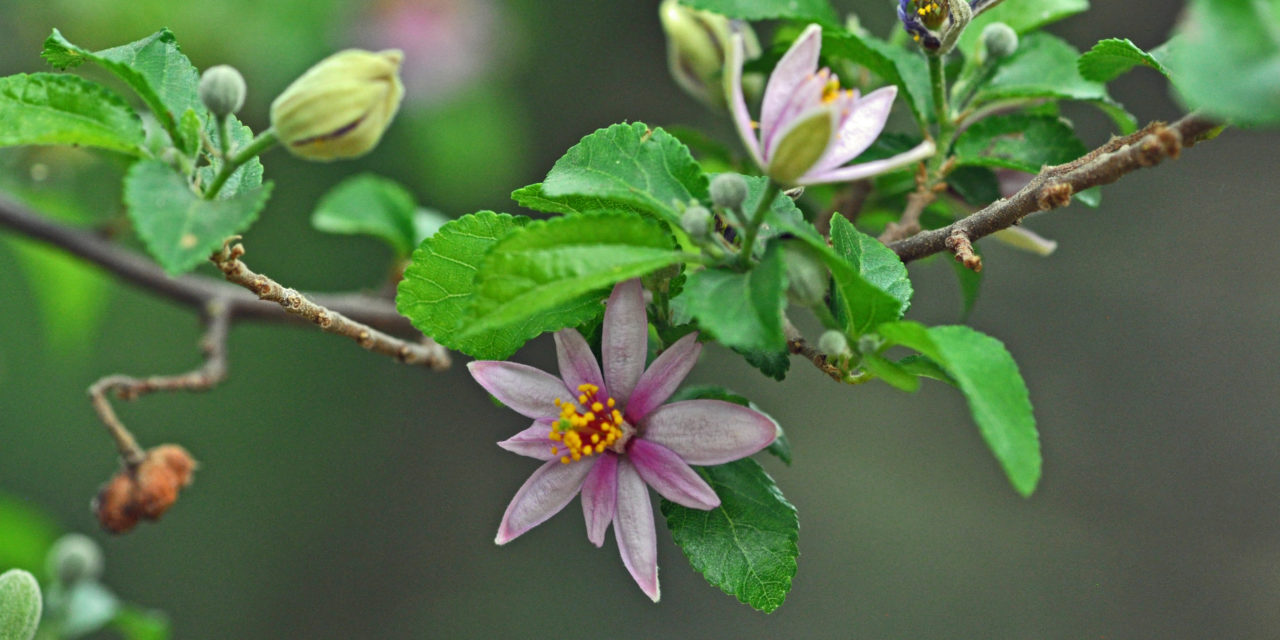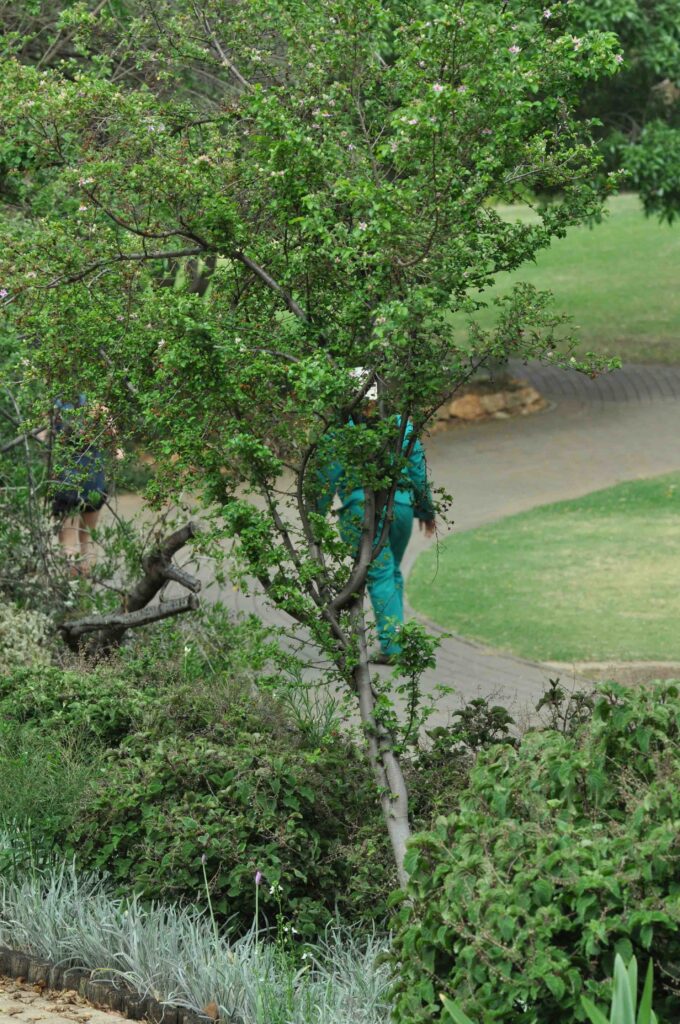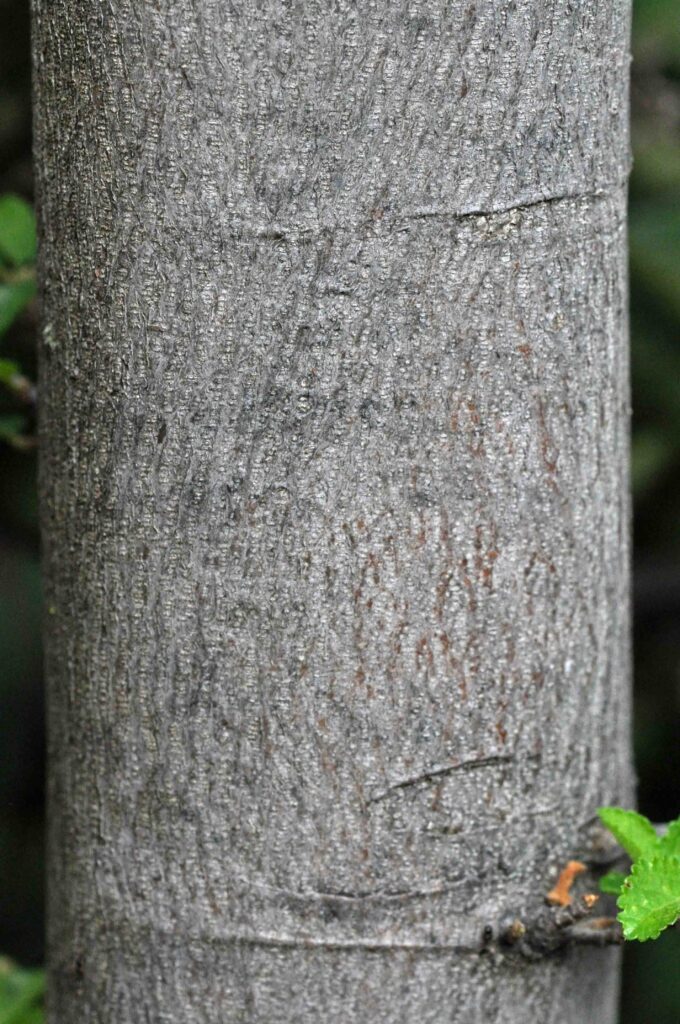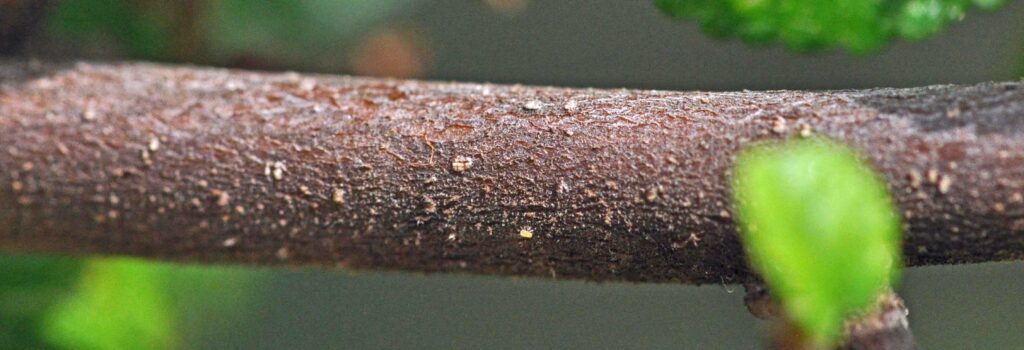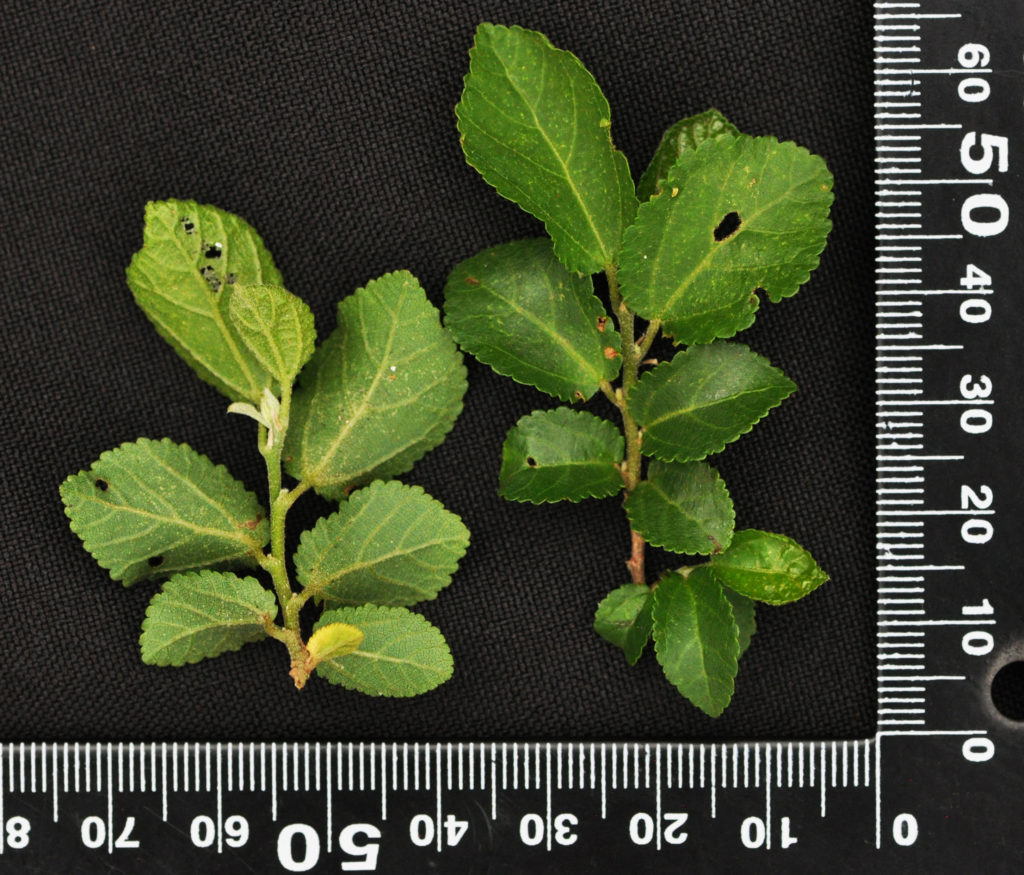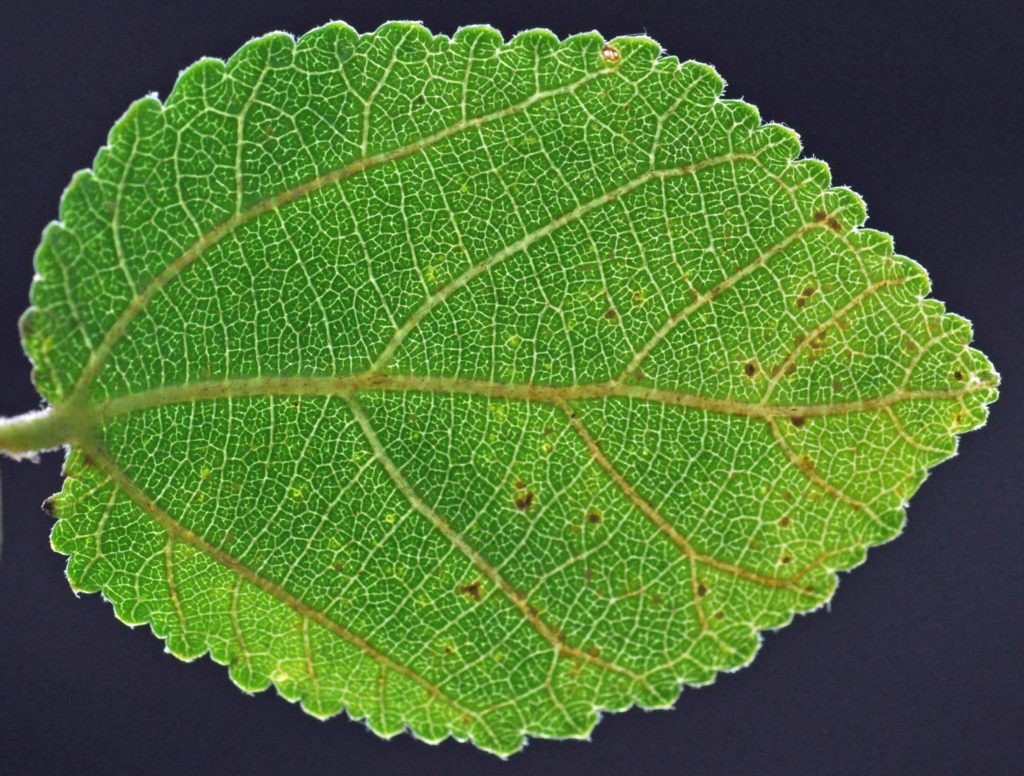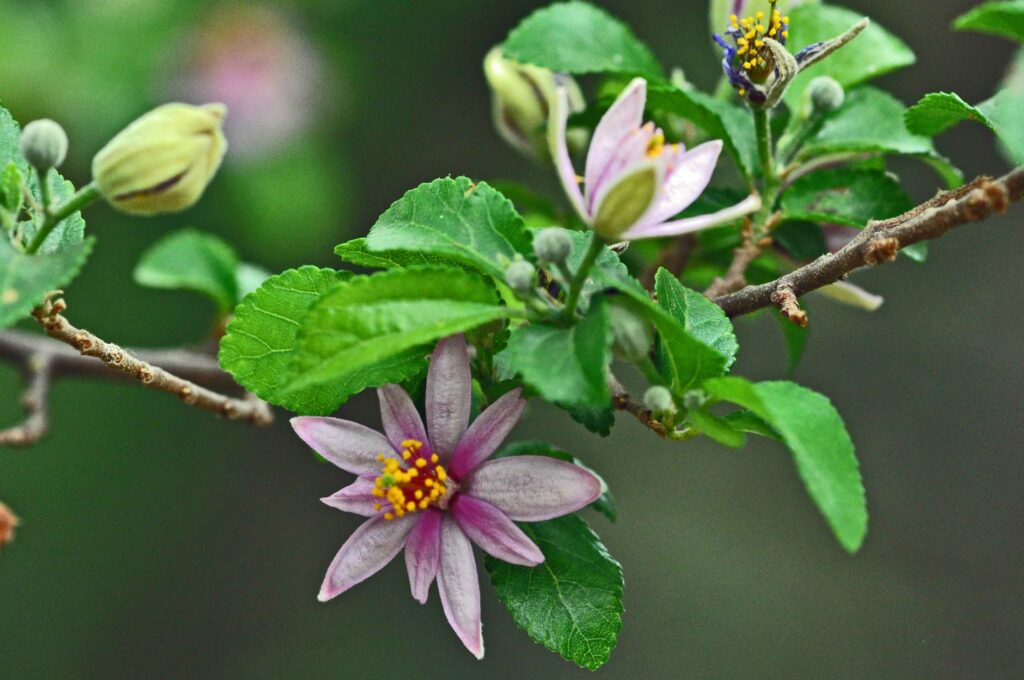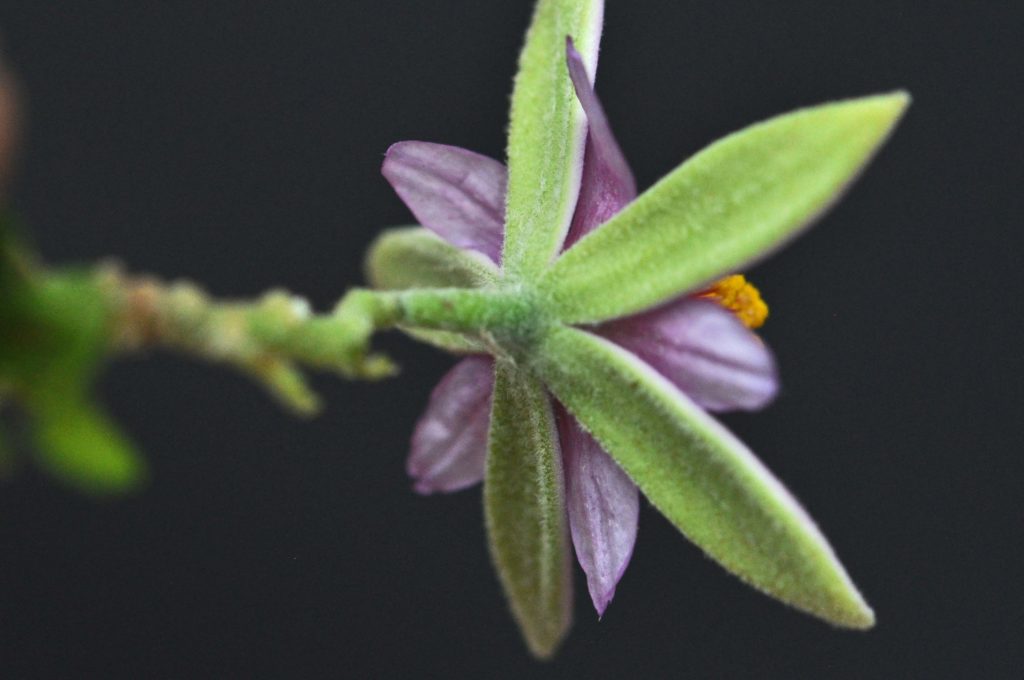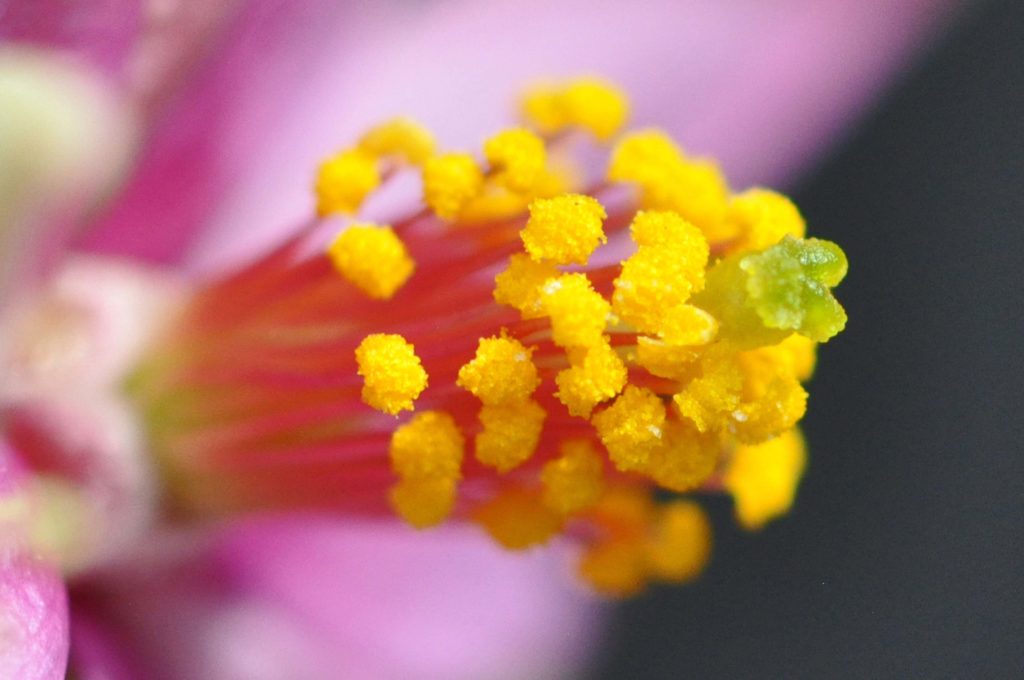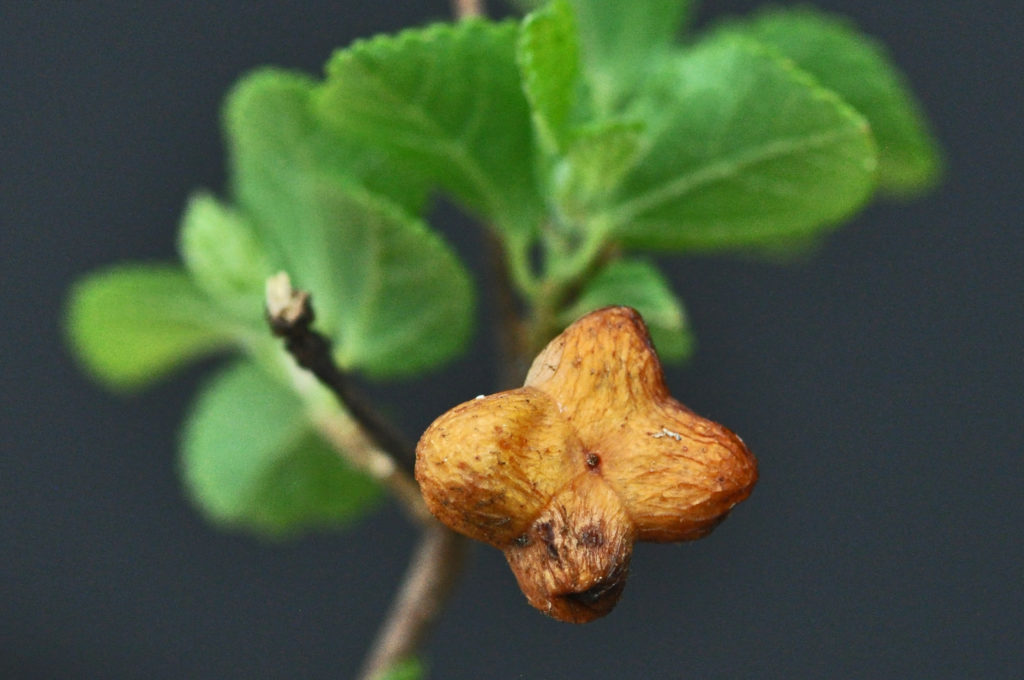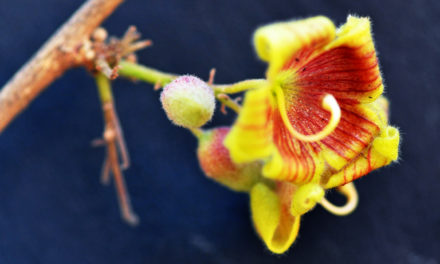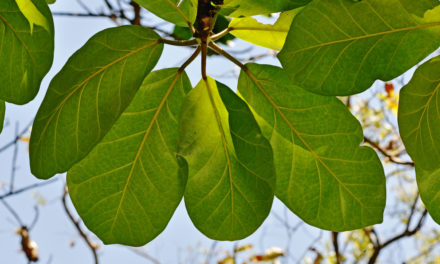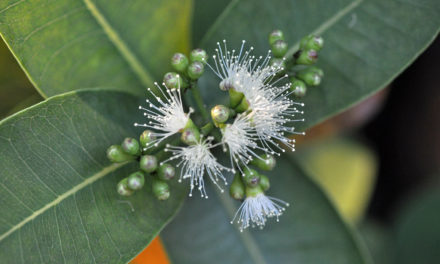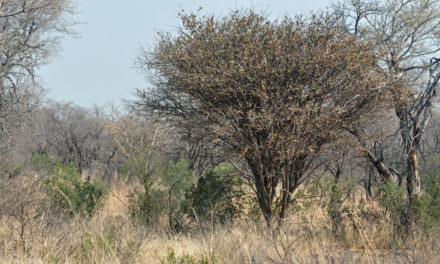General Info – summary
This attractive plant is both drought and frost resistant. The unarmed shrub or small Tree is up 6m high. The simple, serrated and alternate Leaves are 3-veined from the base. The purple star-like 5-merous Flowers have discolorous sepals and many stamens with distinctly red filaments. Ovary is superior and has a lobed green stigma. The usually 4-lobed Fruit is a drupe. A single seed develops in each lobe.
Description
Grewia occidentalis
Previous Names: Grewia chirindae, Grewia microphylla.
RSA Tree No. 463.
Common names: (Afr) Asgaaibos, Assegaaibos, Booghout, Knoppiehout, Kruisbessie, Kruisbessieboom, Pink Grewia, Pylhout, Rosyntjiebos. (Eng) Assegai wood, Bow-wood, Button-wood, Cross-berry, Cross-berry Raisin, Four Corners, Four-corners, Pink Grewia, Star-flower. (Setswana) Liklolo, Morretla. (siSwati) Likloko, Umsipane. (Xitsonga) Mogwana, Mokukutu, Motswetsweyane, Nshana. (Tshivenda) Mulembu. (isiXhosa) Umnqabaza, Uhlolo, Umvilani, Unyenye, Uhlolo-oluncinci. (isiZulu) Ilalanyathi, Imanhlele, Iklolo, Ikolo, Umhlalanyathi.
Family: Malvaceae. (Wild Pear, Gossypium – cotton, baobab and Hibiscus). This family has about 240 genera and 4 200+ species. Indigenous genera that have trees on this website includes Adansonia (baobab), Cola, Dombeya, Grewia, Hibiscus, Sparrmannia and Sterculia. The usually alternate Leaves of all members possess stipules and apart from Adansonia, remain simple. Flowers are regular, bisexual or unisexual and have 5 petals (Sparrmannia africana has 4). Petals are absent in Cola and Sterculia. There are 5 to many stamens with filaments often united into a staminal tube. This surrounds the superior Ovary with its simple Style and capitate or lobed Stigma. Fruits are usually nuts, schizocarps or loculicidal capsules.
Name derivation: Grewia – named after the Englishman Nehemiah Grew – (1641- 1712). He was a physiologist and pioneer plant anatomist and was known as the “Father of Plant Anatomy.” occidentalis relating to the countries of the West. The genus Grewia has more than 400 species, 27 of which are in southern Africa.
Conservation: National Status: L C (Least concern). Assessed: 2005 (W. Foden and L. Potter).
Tree
This may be a small tree up to 9m high but is often a multi-stemmed shrub. The main Stem (main axis of the plant, the leaf and flower bearing as distinguished from the root-bearing axis) has purple to green branchlets that are glossy. The light grey Bark is smooth (photo 356) and young flexible somewhat 4-angled branches contain some Lenticels (a usually raised corky oval or elongated area on the plant that allows the uncontrolled interchange of gases with the environment – photo 358) and become round. The roundish branches may droop and trail. They may have some hairs, which are lost at a later stage leaving smooth round branches. Both thorns and spines are absent.
- 354. 2019/10/24. Walter Sisulu. Photo: David Becking.
- 356. 2019/10/24. Walter Sisulu. Photo: David Becking.
- 358. 2019/10/24. Walter Sisulu. Photo: David Becking.
Leaves
On this occasionally deciduous tree, the alternate (photo 363) and usually symmetric Leaves are thinly textured and simple (have a single blade which may have incisions that are not deep enough to divide the leaf into leaflets). They are slightly ovate to elliptic or lanceolate. This Blade is partly hairy. These hairs are mainly restricted to the veins. The leaf is up to 8 x 4cm – usually smaller (photo 363) and is 3-veined from the rounded or slightly lobed Base (photo 741). Veins reach the margins and are best observed when the leaf is held against a strong light (photo 741). Visible on this photo are the small ladder-like veins that link the main side veins. The Apex is tapering to rounded. The upper surface is a shiny green and the lower surface is a lighter green and dull. The whole Margin is serrated or has blunt teeth (photo 741). The Petiole (leaf stalk) may be short or up to 2,5cm long. It has a thickened base (photo 741) and bends shortly after leaving the stem. The Stipules (basal appendages of the petiole) are small and fall early.
- 363. 2019/10/22 Walter Sisulu NBG. Photo: David Becking.
- 741. 2020/01/20. Walter Sisulu NBG. Photo; David Becking. + sun.
Flowers
The delicate flowers are most impressive. The pink/mauve, lilac or usually purple Flowers are occasionally white. Individual starry flowers may reach 3cm wide and appear directly opposite the leaves. The 5-lobed Calyx has up to 1,8cm long Sepals that are externally hairy and green (photo 349) but inside are nearly the same colour as the 5 Petals (1,4cm) that are pale lavender, pink or mauve and darker towards the base (photo 361). These petals are shorter and narrower than the sepals. The Pedicel (stalk of a single flower) is up to 1,5cm long (photo 349). There is a mass of free Stamens with red Filaments (photo 348). The distinctive yellow Anthers dehisce longitudinally. These attractively contrast with the petal and filament colour (photo 361). From the superior Ovary a single Style emerges, that is slightly longer than the ovary, protrudes beyond the anthers, and terminates in a visible green Stigma that is lobed at the apex (photo 348). (Sep-Jan but may appear throughout the year).
- 361 2019/10/22 Walter Sisulu NBG. Photo: David Becking.
- 349 2019/10/22 Walter Sisulu NBG. Photo: David Becking.
- 348 2019/10/22 Walter Sisulu NBG. Photo: David Becking.
Fruit
The usually clearly 4-lobed (or fewer by abortion) brown, reddish or purple ripe Fruit is a Drupe (or stone fruit, is a fleshy, indehiscent fruit with the seed enclosed in a stony endocarp – also called a pyrene – example in a peach). Beyond the endocarp is a thin fleshy mesocarp surrounded by the skin or exocarp. The fruit is up to 2,5cm wide. When present the 4 lobes of the drupe are in the same squarish plane (photo 359) and tend to face the light. A single Seed develops in each of the 4 pyrenes. The fruit may remain on the plant for a long time. Seeds contain endosperm (the starch and oil-containing tissue of many seeds; often referred to as the albumen). (Dec++)
- 359 2019.10.22 Walter Sisulu NBG. Photo David Becking.
Distribution & Ecology
Grewia occidentalis is Endemic (restricted to a particular geographic location) in southern Africa. This was the first known species of this genus in southern Africa. Grewia occidentalis L. var. occidentalis is the only variety that occurs in South Africa. It occurs over a wide range of altitudes. Most Grewia species grow in relatively dry areas but this plant grows mainly in the moister southern, eastern and northern parts of South Africa up to an altitude of 2 000m. It is common on forest margins, in open bushveld (is a sub-tropical woodland ecoregion of southern Africa) in riverine bush and dry open woodlands. In closed evergreen forests, they may develop as a climber. On dunes, the plant tends to be prostrate. Provincially they occur in the Western Cape – including Table Mountain, Eastern Cape, KwaZulu-Natal, Free State, Gauteng – Johannesburg and Pretoria, Mpumalanga, Limpopo and North West. It is also located in Lesotho, Swaziland, Botswana, southern and central Mozambique and eastern Zimbabwe. The plant is absent from the dry Northern Cape. At higher altitudes it is often found sheltered by taller trees and may be seen on koppies (koppie – a small, erosian remnant remaining behind in the flattish African veld). The Leaves and Stems are consumed by a variety of game including grey duiker, black rhino, giraffe and nyala. Butterflies whose larvae feed on the leaves include the rufous-winged elfin Eagris nottoana and the Buff-tipped skipper Netrobalane canopus. Birds like Speckled Mousebirds (Colius striatus), which are probably involved in seed dispersal, also consume the Fruit. It has become a sought-after garden plant in Auckland New Zealand.
Ethnobotany
The Roots are non-aggressive. The hard Wood is moderately fine-grained and dense. It is used for making bows, spear-shafts, and panga and assegai handles (hence the common name Assegaaibos – Afrikaans for assegai bush). Traditional medicine makes much use of his Plant. It is a useful food for farm herbivores including goats and cattle. The ripe Fruit can be eaten raw. It is used to brew beer. This attractive plant is both drought and frost resistant. The plant attracts butterflies and makes a good addition to a garden. Seeds germinate easily and are the best method of propagation. Cuttings and layering is also used. Plants thrive in full sun or partial shade.
References
Boon, R. 2010. Pooley’s Trees of eastern South Africa. Flora and Fauna Publications Trust, Durban.
Burrows, J.E., Burrows, S.M., Lotter, M.C. & Schmidt, E. Trees and Shrubs Mozambique. Publishing Print Matters (Pty) Ltd. Noordhoek, Cape Town.
Coates Palgrave, M. 2002. Keith Coates Palgrave Trees of Southern Africa, edn 3. Struik, Cape Town.
Foden, W. & Potter, L. 2005. Grewia occidentalis L. var. occidentalis. National Assessment: Red List of South African Plants version 2020.1. Accessed on 2023/07/05.
Ginn P.J. Mcilleron W.G. and Milstein P. le S, 1989. The Complete Book of Southern African Birds. Struik, Cape Town.
Lawrence, G. H. M, 1951. Taxonomy of Vascular Plants, The Macmillan Company, New York. Tenth Printing 1965.
Palmer, E. & Pitman, N. 1972. Trees of southern Africa, Balkema, Amsterdam, Cape Town.
Schmidt, S. Lotter, M. & McCleland, W. 2002. Trees and Shrubs of Mpumalanga and the Kruger National Park.
van Wyk, B. & van Wyk, P. 1997 Field guide to Trees of Southern Africa, Struik, Cape Town.
Woodhall, S. 2020. Field Guide to BUTTERFLIES of South Africa. Struik.
https://en.wikipedia.org/wiki/Nehemiah_Grew
http://pza.sanbi.org/grewia-occidentalis
https://en.wikipedia.org/wiki/Grewia_occidentalis
https://witkoppenwildflower.co.za/grewia-occidentalis/

